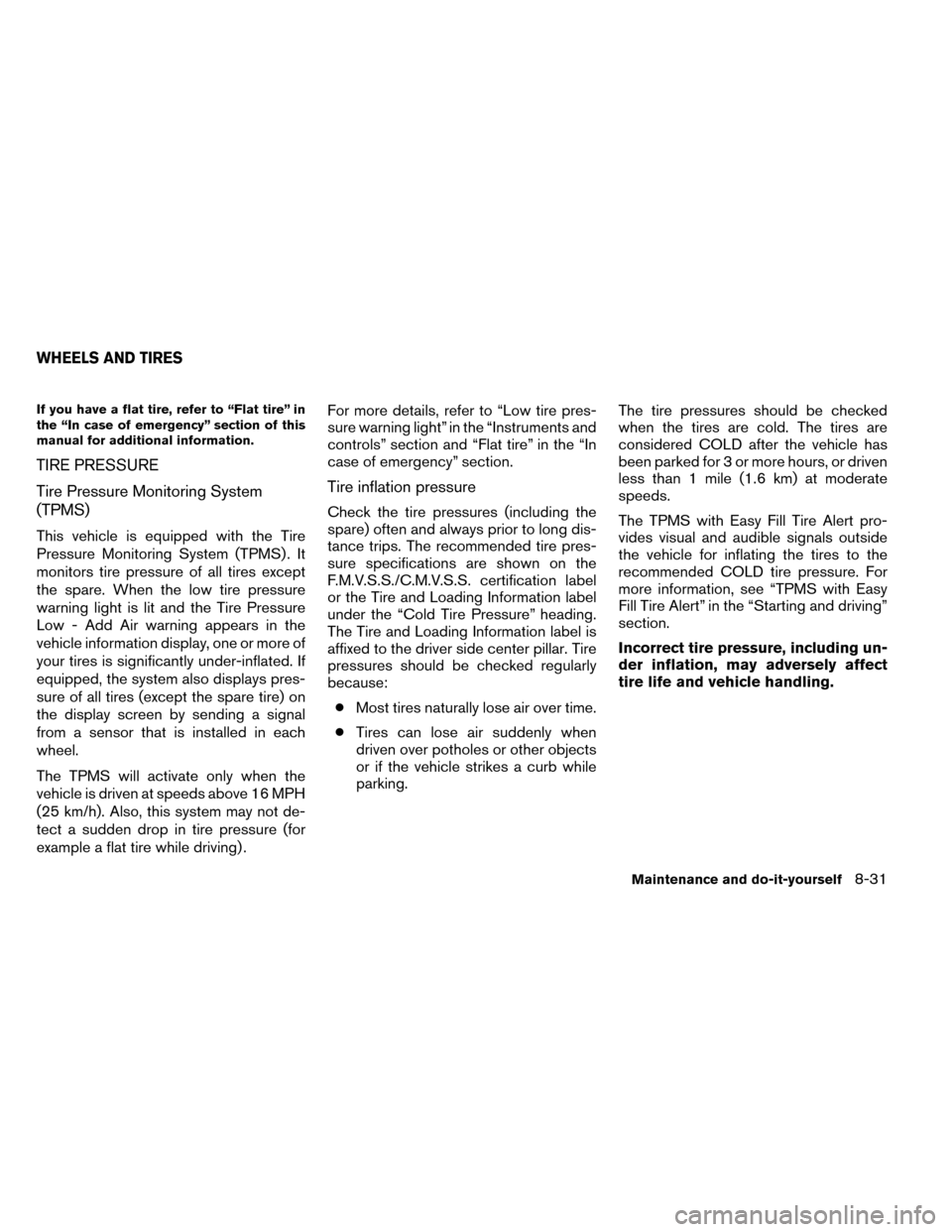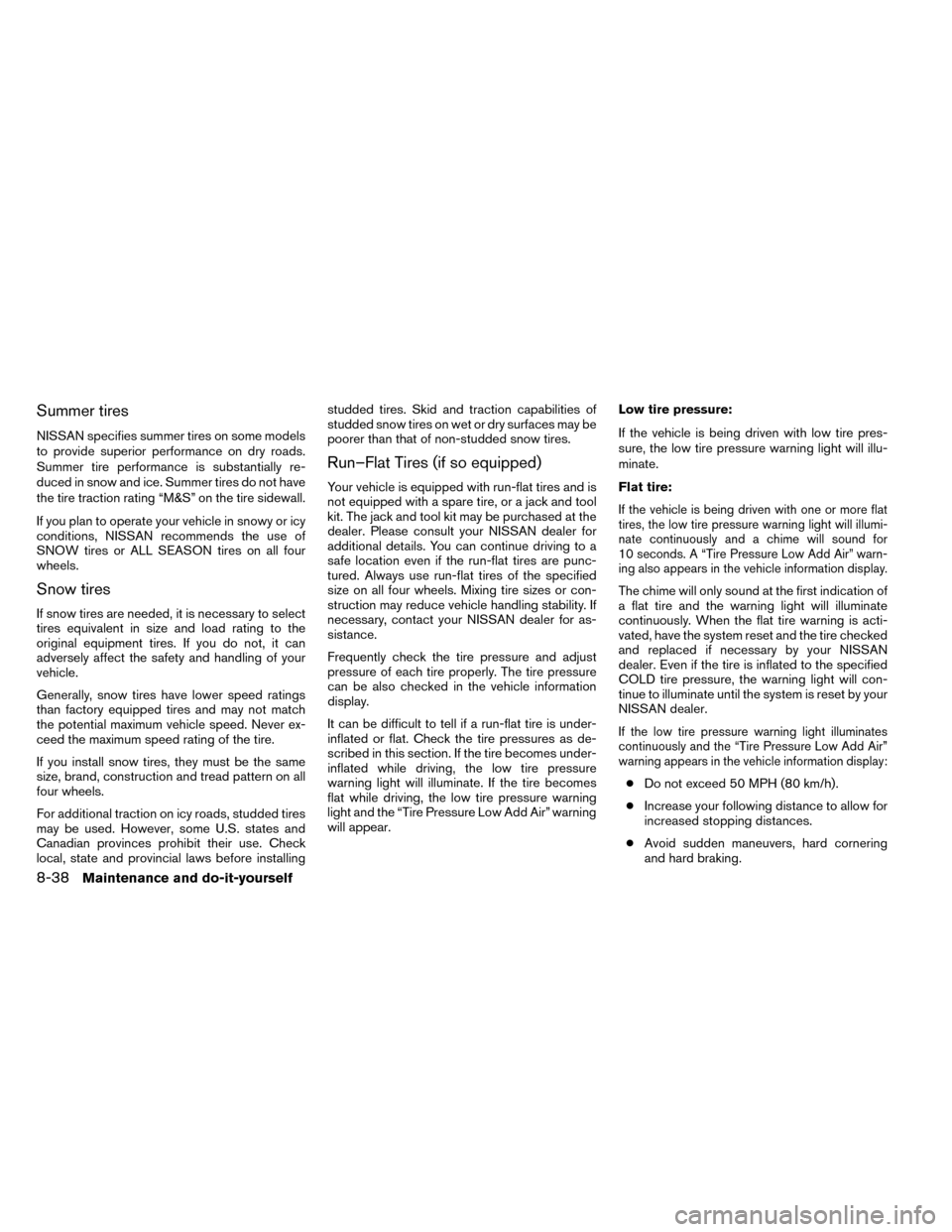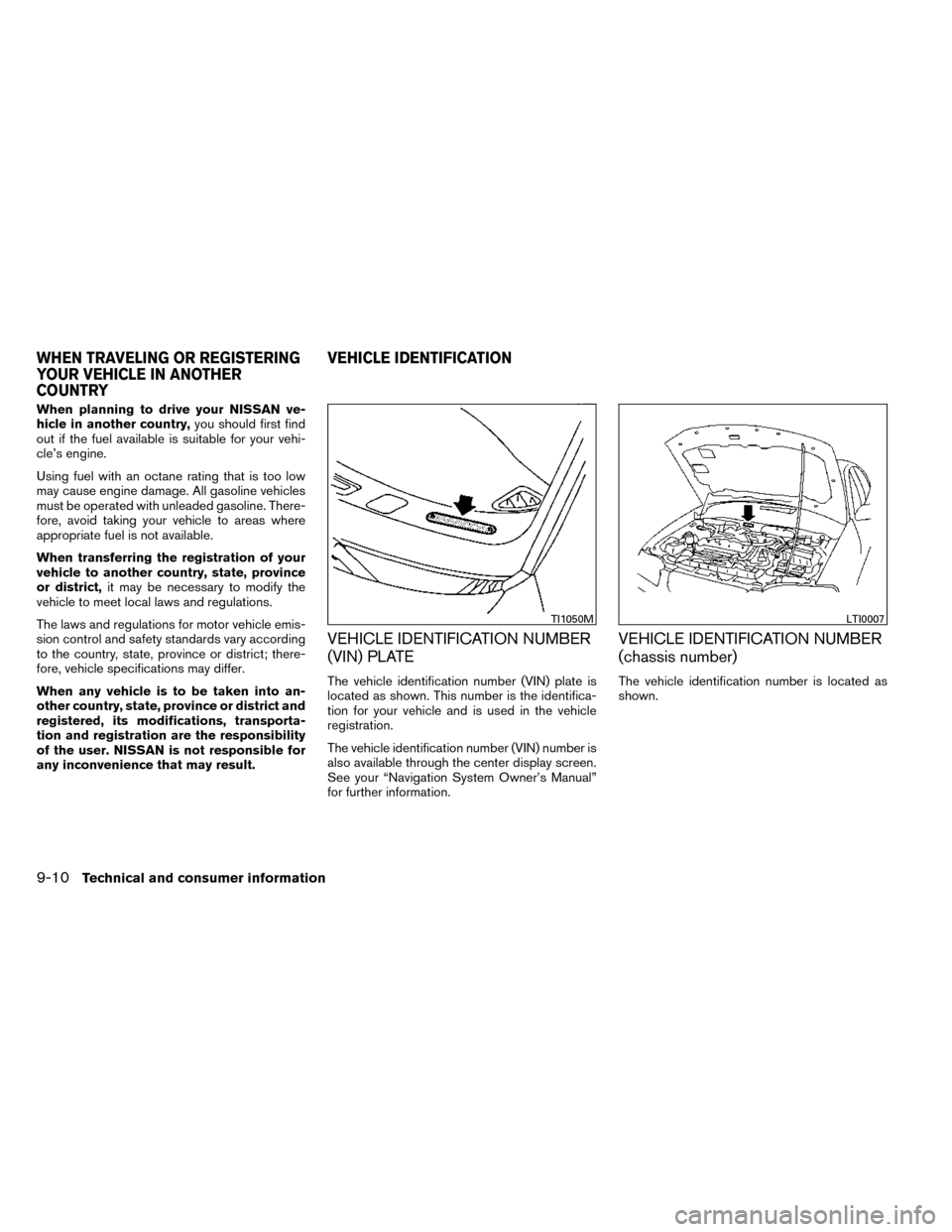2014 NISSAN ROGUE display
[x] Cancel search: displayPage 390 of 442

If you have a flat tire, refer to “Flat tire” in
the “In case of emergency” section of this
manual for additional information.
TIRE PRESSURE
Tire Pressure Monitoring System
(TPMS)
This vehicle is equipped with the Tire
Pressure Monitoring System (TPMS) . It
monitors tire pressure of all tires except
the spare. When the low tire pressure
warning light is lit and the Tire Pressure
Low - Add Air warning appears in the
vehicle information display, one or more of
your tires is significantly under-inflated. If
equipped, the system also displays pres-
sure of all tires (except the spare tire) on
the display screen by sending a signal
from a sensor that is installed in each
wheel.
The TPMS will activate only when the
vehicle is driven at speeds above 16 MPH
(25 km/h). Also, this system may not de-
tect a sudden drop in tire pressure (for
example a flat tire while driving) .For more details, refer to “Low tire pres-
sure warning light” in the “Instruments and
controls” section and “Flat tire” in the “In
case of emergency” section.
Tire inflation pressure
Check the tire pressures (including the
spare) often and always prior to long dis-
tance trips. The recommended tire pres-
sure specifications are shown on the
F.M.V.S.S./C.M.V.S.S. certification label
or the Tire and Loading Information label
under the “Cold Tire Pressure” heading.
The Tire and Loading Information label is
affixed to the driver side center pillar. Tire
pressures should be checked regularly
because:
● Most tires naturally lose air over time.
● Tires can lose air suddenly when
driven over potholes or other objects
or if the vehicle strikes a curb while
parking. The tire pressures should be checked
when the tires are cold. The tires are
considered COLD after the vehicle has
been parked for 3 or more hours, or driven
less than 1 mile (1.6 km) at moderate
speeds.
The TPMS with Easy Fill Tire Alert pro-
vides visual and audible signals outside
the vehicle for inflating the tires to the
recommended COLD tire pressure. For
more information, see “TPMS with Easy
Fill Tire Alert” in the “Starting and driving”
section.
Incorrect tire pressure, including un-
der inflation, may adversely affect
tire life and vehicle handling.
WHEELS AND TIRES
Maintenance and do-it-yourself8-31
Page 397 of 442

Summer tires
NISSAN specifies summer tires on some models
to provide superior performance on dry roads.
Summer tire performance is substantially re-
duced in snow and ice. Summer tires do not have
the tire traction rating “M&S” on the tire sidewall.
If you plan to operate your vehicle in snowy or icy
conditions, NISSAN recommends the use of
SNOW tires or ALL SEASON tires on all four
wheels.
Snow tires
If snow tires are needed, it is necessary to select
tires equivalent in size and load rating to the
original equipment tires. If you do not, it can
adversely affect the safety and handling of your
vehicle.
Generally, snow tires have lower speed ratings
than factory equipped tires and may not match
the potential maximum vehicle speed. Never ex-
ceed the maximum speed rating of the tire.
If you install snow tires, they must be the same
size, brand, construction and tread pattern on all
four wheels.
For additional traction on icy roads, studded tires
may be used. However, some U.S. states and
Canadian provinces prohibit their use. Check
local, state and provincial laws before installingstudded tires. Skid and traction capabilities of
studded snow tires on wet or dry surfaces may be
poorer than that of non-studded snow tires.
Run–Flat Tires (if so equipped)
Your vehicle is equipped with run-flat tires and is
not equipped with a spare tire, or a jack and tool
kit. The jack and tool kit may be purchased at the
dealer. Please consult your NISSAN dealer for
additional details. You can continue driving to a
safe location even if the run-flat tires are punc-
tured. Always use run-flat tires of the specified
size on all four wheels. Mixing tire sizes or con-
struction may reduce vehicle handling stability. If
necessary, contact your NISSAN dealer for as-
sistance.
Frequently check the tire pressure and adjust
pressure of each tire properly. The tire pressure
can be also checked in the vehicle information
display.
It can be difficult to tell if a run-flat tire is under-
inflated or flat. Check the tire pressures as de-
scribed in this section. If the tire becomes under-
inflated while driving, the low tire pressure
warning light will illuminate. If the tire becomes
flat while driving, the low tire pressure warning
light and the “Tire Pressure Low Add Air” warning
will appear.
Low tire pressure:
If the vehicle is being driven with low tire pres-
sure, the low tire pressure warning light will illu-
minate.
Flat tire:
If the vehicle is being driven with one or more flat
tires, the low tire pressure warning light will illumi-
nate continuously and a chime will sound for
10 seconds. A “Tire Pressure Low Add Air” warn-
ing also appears in the vehicle information display.
The chime will only sound at the first indication of
a flat tire and the warning light will illuminate
continuously. When the flat tire warning is acti-
vated, have the system reset and the tire checked
and replaced if necessary by your NISSAN
dealer. Even if the tire is inflated to the specified
COLD tire pressure, the warning light will con-
tinue to illuminate until the system is reset by your
NISSAN dealer.
If the low tire pressure warning light illuminates
continuously and the “Tire Pressure Low Add Air”
warning appears in the vehicle information display:
●
Do not exceed 50 MPH (80 km/h).
● Increase your following distance to allow for
increased stopping distances.
● Avoid sudden maneuvers, hard cornering
and hard braking.
8-38Maintenance and do-it-yourself
Page 411 of 442

When planning to drive your NISSAN ve-
hicle in another country,you should first find
out if the fuel available is suitable for your vehi-
cle’s engine.
Using fuel with an octane rating that is too low
may cause engine damage. All gasoline vehicles
must be operated with unleaded gasoline. There-
fore, avoid taking your vehicle to areas where
appropriate fuel is not available.
When transferring the registration of your
vehicle to another country, state, province
or district, it may be necessary to modify the
vehicle to meet local laws and regulations.
The laws and regulations for motor vehicle emis-
sion control and safety standards vary according
to the country, state, province or district; there-
fore, vehicle specifications may differ.
When any vehicle is to be taken into an-
other country, state, province or district and
registered, its modifications, transporta-
tion and registration are the responsibility
of the user. NISSAN is not responsible for
any inconvenience that may result.
VEHICLE IDENTIFICATION NUMBER
(VIN) PLATE
The vehicle identification number (VIN) plate is
located as shown. This number is the identifica-
tion for your vehicle and is used in the vehicle
registration.
The vehicle identification number (VIN) number is
also available through the center display screen.
See your “Navigation System Owner’s Manual”
for further information.
VEHICLE IDENTIFICATION NUMBER
(chassis number)
The vehicle identification number is located as
shown.
TI1050MLTI0007
WHEN TRAVELING OR REGISTERING
YOUR VEHICLE IN ANOTHER
COUNTRY VEHICLE IDENTIFICATION
9-10Technical and consumer information
Page 435 of 442

Cold weather driving...............5-50
Compact disc (CD)
player ............4-48,4-52,4-57,4-62
Console box ...................2-47
Continuously Variable Transmission (CVT) . . .5-17 Continuously Variable Transmission
(CVT) fluid ..................8-12
Driving with Continuously Variable
Transmission (CVT) .............5-17
Control panel buttons ...............4-4
Brightness/contrast button ..........4-9
Enterbutton..................4-4
Setting button .................4-7
Controls Heater and air conditioner
controls................4-26,4-35
Coolant Capacities and recommended
fuel/lubricants .................9-2
Changing engine coolant ...........8-8
Checking engine coolant level ........8-8
Engine coolant temperature gauge .....2-5
Corrosionprotection ...............7-5
Cruisecontrol..................5-29
Cupholders...................2-45
D
Daytime running light system (Canada only) . .2-37
Defroster switch Rear window and outside mirror defroster
switch.....................2-34
Dimensions and weights .............9-9
Dimmer switch for instrument panel ......2-37
Display controls (see control panel buttons) . .4-4 Door locks
.....................3-5
Drivebelt.....................8-16
Driving Cold weather driving .............5-50
Driving with Continuously Variable
Transmission (CVT) .............5-17
Precautions when starting and driving ....5-2
E
Economy - fuel ..................5-37
Emission control information label .......9-11
Emission control system warranty .......9-29
Engine Before starting the engine ..........5-15
Block heater .................5-51
Capacities and recommended
fuel/lubricants .................9-2
Changing engine coolant ...........8-8
Changing engine oil .............8-10
Changing engine oil filter ..........8-11
Checking engine coolant level ........8-8
Checking engine oil level ...........8-9
Engine compartment check locations ....8-6
Engine coolant temperature gauge .....2-5
Engine cooling system ............8-7
Engine oil ...................8-9
Engine oil and oil filter recommendation . . .9-6
Engine oil viscosity ..............9-6
Engine serial number ............9-11
Engine specifications .............9-8
Starting the engine ..........5-15,5-16
Enterbutton....................4-4
Event data recorders ..............9-31
Exhaust gas (Carbon monoxide) .........5-2Extended storage switch
............8-24
Eyeglass case ..................2-44
F
Flashers (See hazard warning flasher switch) . .6-2
Flat tire .......................6-3
Floormatpositioningaid.............7-5
Fluid Capacities and recommended
fuel/lubricants .................
9-2
Continuously Variable Transmission (CVT)
fluid......................8-12
Engine coolant .................8-7
Engine oil ...................8-9
Windshield-washer fluid ...........8-12
F.M.V.S.S. certification label ...........9-11
Foglightswitch .................2-38
Forward Collision Warning system .......5-31
Front air bag system
(See supplemental restraint system) ......1-48
Front seats .....................1-2
Fuel Capacities and recommended
fuel/lubricants .................9-2
Fuel economy ................5-37
Fuel-filler door and cap ...........3-27
Fuel-filler door lock opener lever ......3-27
Fuel gauge ...................2-5
Fuel octane rating ...............9-5
Fuel recommendation .............9-4
Loose fuel cap warning ........2-28,3-27
Fuses .......................8-21
Fusible links ...................8-22
10-2